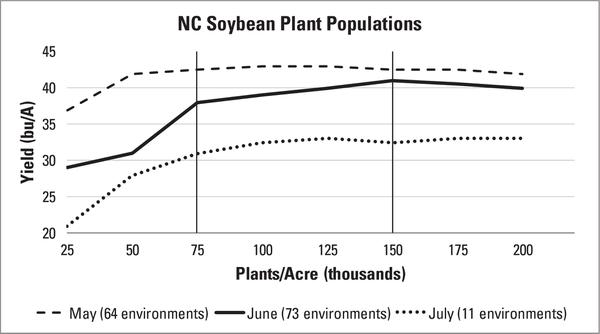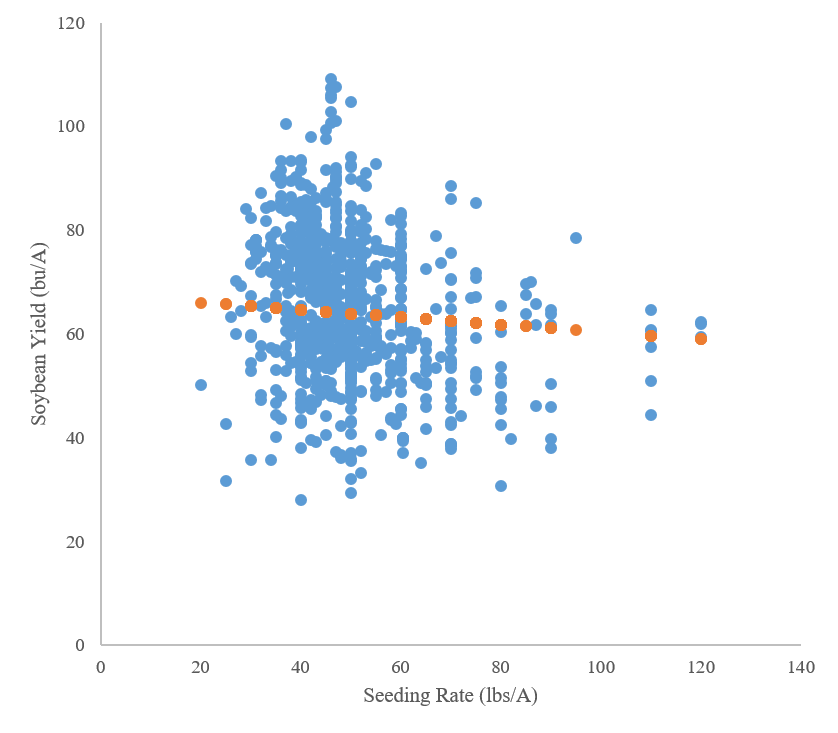PFP21: Soybean Seeding Rate
go.ncsu.edu/readext?785796
en Español / em Português
El inglés es el idioma de control de esta página. En la medida en que haya algún conflicto entre la traducción al inglés y la traducción, el inglés prevalece.
Al hacer clic en el enlace de traducción se activa un servicio de traducción gratuito para convertir la página al español. Al igual que con cualquier traducción por Internet, la conversión no es sensible al contexto y puede que no traduzca el texto en su significado original. NC State Extension no garantiza la exactitud del texto traducido. Por favor, tenga en cuenta que algunas aplicaciones y/o servicios pueden no funcionar como se espera cuando se traducen.
Português
Inglês é o idioma de controle desta página. Na medida que haja algum conflito entre o texto original em Inglês e a tradução, o Inglês prevalece.
Ao clicar no link de tradução, um serviço gratuito de tradução será ativado para converter a página para o Português. Como em qualquer tradução pela internet, a conversão não é sensivel ao contexto e pode não ocorrer a tradução para o significado orginal. O serviço de Extensão da Carolina do Norte (NC State Extension) não garante a exatidão do texto traduzido. Por favor, observe que algumas funções ou serviços podem não funcionar como esperado após a tradução.
English
English is the controlling language of this page. To the extent there is any conflict between the English text and the translation, English controls.
Clicking on the translation link activates a free translation service to convert the page to Spanish. As with any Internet translation, the conversion is not context-sensitive and may not translate the text to its original meaning. NC State Extension does not guarantee the accuracy of the translated text. Please note that some applications and/or services may not function as expected when translated.
Collapse ▲Preparing for Plant 21 (PFP21): Soybean Seeding Rate
Soybean is a plastic crop that can perform well across a wide range of populations, however seed is one of the largest variable input costs for soybean producers and it is important to understand what seeding rates maximize profit without compromising yield. This national Extension publication does an excellent job of describing this in more detail. The interest in using lower soybean seeding rates is driven not only by seed cost but also the shift from drilling soybeans to precision planting coupled with the reliance on herbicide-resistant soybean varieties that enable herbicides as the primary mechanism of weed control.
Historical recommendations for North Carolina: A tremendous amount of seeding rate work was carried out under Dr. Jim Dunphy. This work was largely conducted with determinate varieties and indicated that growers should aim for final stands of 75,000, 90,000, and 100,000 plants/A for May, June, and July planted soybeans, respectively. When making replanting decisions for soybeans, these are our current thresholds to ensure that population is not limiting yield. As with many agronomic situations across the USA, higher seeding rates are needed in North Carolina as planting is delayed to ensure these final populations are achieved. The number of seeds/A planted must be higher than these targeted populations to account for various factors impacting realized stand including germination, weather conditions, soil conditions, and pest pressure. To ensure these final populations are achieved, growers need to correct their seeding rates for the reported germination of their purchased varieties and consider other factors that may adversely impact early season growth. If growers are planting before mid-May, using a fungicidal seed treatment has been found in recent research to protect both stand and yield in North Carolina.

Figure 1. Soybean populations needed to maximize soybean yield based on historical data generated largely with determinate varieties in North Carolina.
Recent seeding rate research in North Carolina: More recently (2019 and 2020) the NC State Extension Soybean program has been investigating the seeding rates needed to maximize yield across a broad range of planting date and maturity group combinations. This work will continue for several more years and then economic analyses will occur and our seeding rate recommendations will be updated if merited. These preliminary results indicate that across most planting dates, yield plateaued around moderate seeding rates (125,000 seeds/A) and yield tended to be more sensitive to higher seeding rates as planting date was delayed (Figure 2). Unlike some previous research in other USA regions, soybean yield was less sensitive to seeding rate in the early planting situations employed across both yield environments (Figure 2). In our research, the response of soybean yield to seeding rate tended to be consistent across yield environments (Figure 2), however recent research from other parts of the USA has indicated that often higher seeding rates are needed in low-yield versus higher-yield environments. Maturity group did not interact with seeding rate to impact soybean yield, meaning there was a similar response of soybean yield to seeding rate across maturity groups. Other recent research conducted by County Extension agents across the state documented yield penalties of soybean seeding rates below 100,000 seeds/A when planted in May for MG III and IV varieties. It is worth noting that at each seeding rate, we typically saw a higher percent of planted seeds translate into plants with the later than the earlier maturing varieties, which is likely attributed to the adaptability of later maturing varieties for production in our environment.

Figure 2. Impact of seeding rate on soybean yield in high and low yield environments across planting dates combined over MG2-7. Results from research conducted across North Carolina in 2019 and 2020.
Seeding Rate Impact in the North Carolina Soybean Yield Contest: We have recently conducted an analysis of 877 North Carolina Soybean Yield Contest Entries to identify the production practices that were the strongest predictors of high soybean yield in North Carolina from 2002-2019. Planting earlier maturing varieties (MG≤4), planting before mid-May, and the use of a foliar fungicide were the strongest predictors of yield, but we also investigated the impact of seeding rate on soybean yield in this analysis. There was a slight downward trend in yield associated with the use of higher seeding rates (Figure 3), indicating that in high yield environments there were yield advantages to using lower seeding rates. In the statewide analysis of all 877 yield contest entries from 2002-2019, when planting later than May 12 and using an MG≤4 variety, using a seeding rate <130,000 seeds/A resulted in a 7 bu/A yield advantage over using higher seeding rates.



